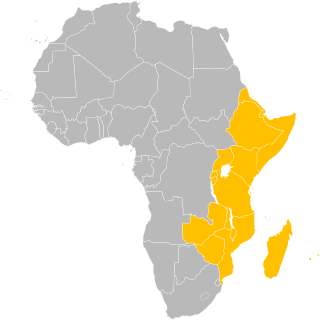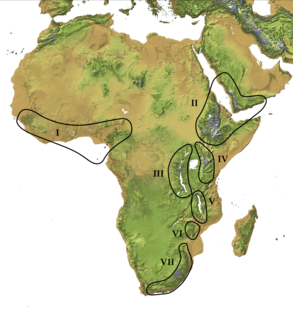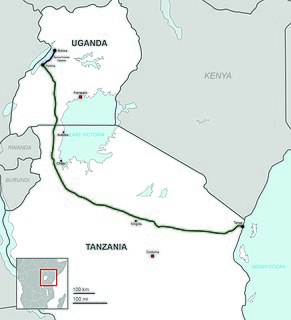
The geography of Kenya is diverse, varying amongst Kenya's 47 Counties. Kenya has a coastline on the Indian Ocean, which contains swamps of East African mangroves. Inland are broad plains and numerous hills. Kenya borders South Sudan to the northwest, Uganda to the west, the Jubaland province of Somalia to the east, Tanzania to the south, and Ethiopia to the north.

Apollo Milton Obote was a Ugandan political leader who led Uganda to independence in 1962 from British colonial administration. Following the nation's independence, he served as prime minister of Uganda from 1962 to 1966 and the second president of Uganda from 1966 to 1971, then again from 1980 to 1985. He was overthrown in a coup d'état by Idi Amin in 1971, but was re-elected in 1980 a year after Amin's 1979 overthrow. His second period of rule ended after a long and bloody conflict known as the Ugandan Bush War, during which he was overthrown a second time by another coup d'état in 1985, prompting him to live the rest of his life in exile.

East Africa, Eastern Africa, or East of Africa is the eastern sub-region of the African continent. In the United Nations Statistics Division scheme of geographic regions, 19* territories make up Eastern Africa:

The Luo are several ethnically and linguistically related Nilotic ethnic groups that inhabit an area ranging from Egypt and Sudan to South Sudan and Ethiopia, through Northern Uganda and eastern Congo (DRC), into western Kenya, and the Mara Region of Tanzania. Their Luo languages belong to the western branch of the Nilotic language family.

The East-Central Africa Division (ECD) of Seventh-day Adventists is a sub-entity of the General Conference of Seventh-day Adventists, which oversees the Church's work in portions of Africa, which includes the nations of Djibouti, Eritrea, Somalia, Ethiopia, Kenya, Tanzania, Uganda, Rwanda, Burundi, South Sudan and the Democratic Republic of the Congo. Its headquarters is in Nairobi, Kenya. The Division membership as of June 30, 2020 is 4,452,526.

Paranthropus aethiopicus is an extinct species of robust australopithecine from the Late Pliocene to Early Pleistocene of East Africa about 2.7–2.3 million years ago. However, it is much debated whether or not Paranthropus is an invalid grouping and is synonymous with Australopithecus, so the species is also often classified as Australopithecus aethiopicus. Whatever the case, it is considered to have been the ancestor of the much more robust P. boisei. It is debated if P. aethiopicus should be subsumed under P. boisei, and the terms P. boisei sensu lato and P. boisei sensu stricto can be used to respectively include and exclude P. aethiopicus from P. boisei.

Mara Region is one of Tanzania's 31 administrative regions. The regional capital is the municipality of Musoma. Mara region is known for being the home of Serengeti National Park, a UNESCO World Heritage site and also the birth place of Tanzania's founding father Julius Nyerere. According to the 2012 national census, the region had a population of 1,743,830, which was lower than the pre-census projection of 1,963,460. For 2002–2012, the region's 2.5 percent average annual population growth rate was the thirteenth highest in the country. It was also the twelfth most densely populated region with 80 people per square kilometer.

The Afromontane regions are subregions of the Afrotropical realm, one of the Earth's eight biogeographic realms, covering the plant and animal species found in the mountains of Africa and the southern Arabian Peninsula. The Afromontane regions of Africa are discontinuous, separated from each other by lower-lying areas, and are sometimes referred to as the Afromontane archipelago, as their distribution is analogous to a series of sky islands.

The baglafecht weaver is a species of weaver bird from the family Ploceidae which is found in eastern and central Africa. There are several disjunct populations with distinguishable plumage patterns. Only some races display a discrete non-breeding plumage.

Self Help Africa is an international charity that promotes and implements long-term rural development projects in Africa. Self Help Africa merged with Gorta in July 2014, and the group of companies operates under the Self Help name.
One Acre Fund is a nonprofit organization that supplies smallholder farmers in East Africa with asset-based financing and agriculture training services to reduce hunger and poverty. Headquartered in Kakamega, Kenya, the organization works with farmers in rural villages throughout Kenya, Rwanda, Burundi, Tanzania, Uganda, Malawi, Nigeria, Zambia, Ethiopia, and India.

Trees for the Future is a Maryland-based nonprofit organization founded on April 12, 1989, that helps communities around the world plant trees. Through seed distribution, agroforestry training, and in-country technical assistance, it has empowered rural groups to restore tree cover to their lands, protect the environment and help to preserve traditional livelihoods and cultures for generations.
Alliance for a Green Revolution in Africa (AGRA) is an organisation that seeks to transform African agriculture from a subsistence model to strong businesses that improve the livelihoods of the continent’s farming households.

The East African Crude Oil Pipeline (EACOP), also known as the Uganda–Tanzania Crude Oil Pipeline (UTCOP), is under construction and intended to transport crude oil from Uganda's oil fields to the Port of Tanga, Tanzania on the Indian Ocean. Once completed, the pipeline will be the longest heated crude oil pipeline in the world. Because of the large scale displacement of communities and wildlife, global environmental groups are protesting its construction and finance.
Uganda is the largest producer of granular brown sugar in the East African Community, accounting for about 500,000 metric tonnes annually as of May 2017.

The Victoria Basin forest–grassland mosaic is an ecoregion that lies mostly in Uganda and extends into neighboring countries. The ecoregion is centered north and west of Lake Victoria, with an outlier on the border of Ethiopia and South Sudan.
The following lists events that happened during 2020 in East Africa. The countries listed are those described in the United Nations geoscheme for East Africa: Burundi, Comoros, Djibouti, Eritrea, Ethiopia, Kenya, Madagascar, Malawi, Mauritius, Mayotte, Mozambique, Réunion, Rwanda, Seychelles, Somalia, South Sudan, Tanzania, Uganda, Zambia, Zimbabwe.
Events that happened during 2021 in East Africa. The countries listed are those described in the United Nations geoscheme for East Africa.












